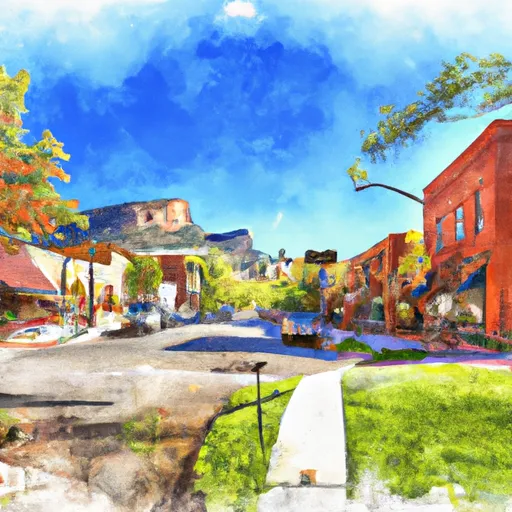-
 Snoflo Premium
Snoflo Premium
Get unlimited access to all our content
With no Ad interruptions! - Start Your Free Trial Login with existing account
Lyons
Eden Index
Climate
8.2
•
Recreation
7.8
•
Community
•
Safeguard
6.0/10

Lyons, Colorado is a small town nestled in the Rocky Mountains, offering a unique blend of natural beauty and outdoor recreation opportunities. The climate in Lyons is characterized by mild summers and cold winters, making it an ideal destination for outdoor enthusiasts year-round.
The hydrology constituents in Lyons are primarily influenced by the North and South St. Vrain Creeks, which flow through the town. These creeks provide a picturesque setting for fishing, kayaking, and other water-based activities. Additionally, the nearby Rocky Mountain National Park offers breathtaking waterfalls and scenic hiking trails.
Outdoor recreation opportunities in Lyons are abundant and diverse. The town is surrounded by stunning natural landscapes, including the Roosevelt National Forest, which boasts numerous hiking, biking, and horseback riding trails. Climbing enthusiasts can explore the nearby cliffs and canyons, while avid cyclists can take advantage of the scenic roadways and mountain bike trails.
Lyons also hosts several annual events and festivals, such as the RockyGrass bluegrass festival, attracting music lovers from all over the country. With its beautiful climate, diverse hydrology constituents, and myriad outdoor recreation opportunities, Lyons is a haven for nature lovers and adventure seekers alike.
What is the Eden Index?
The Snoflo Eden Index serves as a comprehensive rating system for regions, evaluating their desirability through a holistic assessment of climate health, outdoor recreation opportunities, and natural disaster risk, acknowledging the profound impact of these factors on livability and well-being.
Climate Health Indicator (CHI): 8.2
Lyons receives approximately
485mm of rain per year,
with humidity levels near 50%
and air temperatures averaging around
9°C.
Lyons has a plant hardyness factor of
5, meaning
plants and agriculture in this region thrive during a short period during spring and early summer. Most
plants will die off during the colder winter months.
By considering the ideal temperature range, reliable water supplies, clean air, and stable seasonal rain or snowpacks, the Climate Health Indicator (CHI) underscores the significance of a healthy climate as the foundation for quality living.
A healthy climate is paramount for ensuring a high quality of life and livability in a region, fostering both physical well-being and environmental harmony. This can be characterized by ideal temperatures, reliable access to water supplies, clean air, and consistent seasonal rain or snowpacks.
Weather Forecast
Streamflow Conditions
South Platte
Area Rivers
South Platte
Snowpack Depths
South Platte
Reservoir Storage Capacity
South Platte
Groundwater Levels
Recreational Opportunity Index (ROI): 7.8
The Recreational Opportunity Index (ROI) recognizes the value of outdoor recreational options, such as parks, hiking trails, camping sites, and fishing spots, while acknowledging that climate plays a pivotal role in ensuring the comfort and consistency of these experiences.
Access to outdoor recreational opportunities, encompassing activities such as parks, hiking, camping, and fishing, is crucial for overall well-being, and the climate plays a pivotal role in enabling and enhancing these experiences, ensuring that individuals can engage in nature-based activities comfortably and consistently.
Camping Areas
| Campground | Campsites | Reservations | Toilets | Showers | Elevation |
|---|---|---|---|---|---|
| Bear Creek Lake Park | 52 | 5,693 ft | |||
| Deer Creek | 13 | 9,092 ft | |||
| Standley Lake | None | 5,530 ft | |||
| Clear Creek RV Park | 36 | 5,684 ft | |||
| Aspen Meadow - Golden Gate Canyon State Park | 35 | 9,000 ft | |||
| Reverends Ridge - Golden Gate State Park | 106 | 9,105 ft | |||
| Camp Dick | 41 | 8,716 ft | |||
| Cold Springs | 38 | 9,331 ft | |||
| Kelly Dahl | 46 | 8,615 ft | |||
| Meridian | 18 | 9,013 ft |
Nearby Ski Areas
Catastrophe Safeguard Index (CSI):
The Catastrophe Safeguard Index (CSI) recognizes that natural disaster risk, encompassing floods, fires, hurricanes, and tornadoes, can drastically affect safety and the overall appeal of an area.
The level of natural disaster risk in a region significantly affects safety and the overall livability, with climate change amplifying these risks by potentially increasing the frequency and intensity of events like floods, fires, hurricanes, and tornadoes, thereby posing substantial challenges to community resilience and well-being.
Community Resilience Indicator (CRI):
The Community Resilience Indicator (CRI) recognizes that education, healthcare, and socioeconomics are crucial to the well-being of a region. The CRI acknowledges the profound impact of these elements on residents' overall quality of life. By evaluating educational resources, healthcare accessibility, and economic inclusivity, the index captures the essential aspects that contribute to a thriving community, fostering resident satisfaction, equity, and social cohesion.

